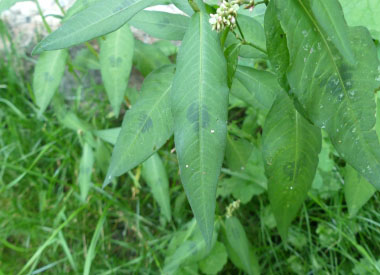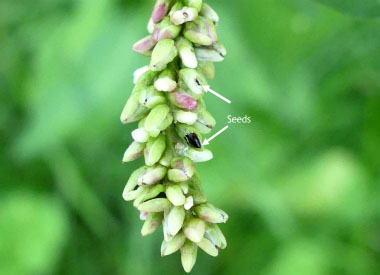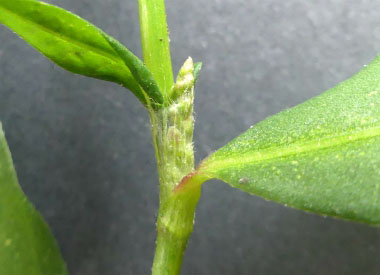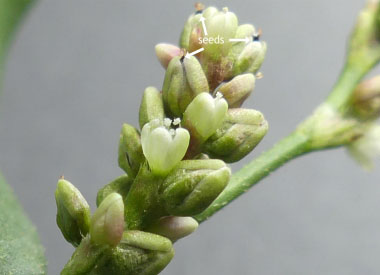







To support our efforts please browse our store (books with health benefits, etc.).
Lady’s thumb is an annual plant in the buckwheat/smartweed (Polygonaceae) family. Other common names include spotted lady's thumb and redshank. It is a summer annual, herbaceous, broadleaved plant that is not well-recognized as being an edible plant. Native Americans used the leaves in treatments of stomach pains and poison ivy. They also rubbed the plant on their horses as an insect repellant. Also known as Persicaria maculosa, the flowers attracts Halictid bees, wasps, and Syrphid flies. Mammalian herbivores rarely feed on the foliage of this plant because the foliage is peppery, and slightly bitter. However, white-tailed deer may chomp on it on occasion. The seeds are very popular with granivorous songbirds.
Distinguishing Features
Lady’s thumb is distinguished from other members of the smartweed family by a combination of characteristics such as: The undersurface of the leaves are without matted white hair or yellowish glands. This plant’s ocrea has very tiny hairs on the surface and a fringe of longer hair on the margin that is barely seen to the naked eye. The stem lacks glands on the upper portion near the spikes of flowers. The reddish or purplish blotch is usually present on the upper surface of the leaves but there are some leaves that are without this marking.
Flowers
Flowers are small, densely crowded into narrow cylindrical spikes that occur at the ends of stems and branches. Each flower has 5 pinkish sepals 2 to 4mm (1/12 to 1/6”) long, sometimes nearly white or purple; fruits (seeds) are enclosed by the sepals when mature and are shiny, smooth, and black. Each flower is completely absent of petals forming slightly ovate grain-like structures. Lady’s thumb flowers typically occur from June to mid-September.
 Fields
of Nutrition has medicinal benefits and vitamin/mineral content of Lady's Thumb.
Fields
of Nutrition has medicinal benefits and vitamin/mineral content of Lady's Thumb.
Leaves
Leaves grow alternate (1 per node), are narrowly elliptic, 2 to 15cm (4 to 6”) long, greenish above and slightly paler below, usually with a reddish to brownish or purplish blotch near the middle. The undersurface of the leaf is often slightly rough with tiny bumps, but never glandular or hairy. The ocrea occurs with the leafstalk at each node, membranous and somewhat papery and its surface is covered with short, upward slanting hairs that measure 1 to 2 mm (1/25 to 1/12”) long.
Height
Stems are erect from a taproot, 20 to 100cm (8 to 40”) high, green or reddish, smooth except for being slightly swollen at the distinct node. The jointed stem typically turns red as the season progresses.
Habitat
Lady's-thumb occurs in cultivated lands, in backyards, in fields, roadsides, and in disturbed areas. It tends to thrive in nearly all soil textures but tends to prefer damp clearings. It grows across Canada and the U.S., Mexico, Europe, Asia, some South American countries, the Middle East, Australia and New Zealand, as well as some island nations.
Edible Parts
The leaves, young shoots, flowers and seeds are edible. Lady's thumb contains natural fibers, sugars, fats and tannins. They also contain high amounts of phenolic acids.
Other Name
Redshank.
Winter Survival Food Handbook

PDF Plant Magazines
Types of Wild Food
Geographic Zones Seasons
Disclaimer
EdibleWildFood.com is informational in nature. While we strive to be 100% accurate, it is solely up to the reader to ensure proper plant identification. Some wild plants are poisonous or can have serious adverse health effects.
We are not health professionals, medical doctors, nor are we nutritionists. It is up to the reader to verify nutritional information and health benefits with qualified professionals for all edible plants listed in this web site. Please click here for more information.
Why Edible Wild Food?
- Food costs are rising
- Free, wild food is readily abundant
- Wild food adds nutrition to your diet
- Wild food can help treat various medical conditions





